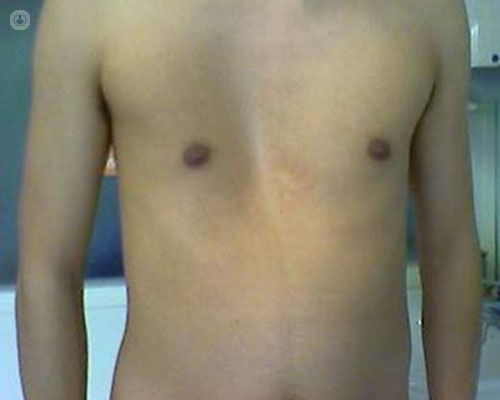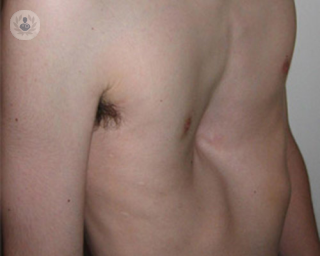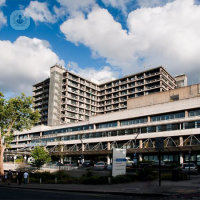What is pectus excavatum?
This is a congenital deformity of the rib cage in which the breastbone is sunken into the chest. If pectus excavatum is not treated, it can cause compression (pressure) of the lungs and heart.

Is pectus excavatum serious?
Severe cases of pectus excavatum are serious because they eventually interfere with heart and lung function. It's important to see a specialist in order to look at treatment solutions for this, including surgery.
What are the symptoms?
The main symptoms of pectus excavatum include:
- Difficulty breathing
- Chest pain
- Resistance to exercise
- Wheezing or coughing
- Fatigue
What causes pectus excavatum?
Researchers believe that pectus excavatum is due to an irregular growth of connective tissue (cartilage) that connects the ribs to the breastbone. This irregular growth causes the breastbone to move inwards.
Can it be prevented?
Unfortunately, pectus excavatum cannot be prevented, but the good news is that it can be treated.
Can pectum excavatum get worse?
Pectum excavatum can get worse in children as they age. It often gets worse around the time puberty begins, between 12 to 14 years.
Symptoms also may start to present once this occurs.
What does treatment involve?
If pectus excavatum causes problems in the heart or lungs, doctors may recommend surgery. The aim is to improve breathing, function, and heart position. There are several surgical procedures for this purpose:
The Nuss procedure
This is a non-invasive technique. A small incision is made to insert a camera that allows the surgeon to see inside the chest. Then, through two other incisions on each side of the chest, a curved steel bar is inserted under the breastbone to reverse the depression. It is not visible from the outside and remains there for two to three years before eventually being removed.
The Ravitch procedure
This is performed through an incision made in the middle of the chest to remove the cartilage. Stainless steel bars are then put in place to support the sternum and the corresponding ribs are connected. This allows the sternum to be lifted. These will later be removed in another operation.
It is also possible to correct pectus excavatum without surgery, with vacuum bell therapy. However, this is very uncomfortable and requires perseverance and years of application to correct the problem.
11-13-2012 07-05-2023Pectus excavatum
Mr Shyamsunder Kolvekar - Cardiothoracic surgery
Created on: 11-13-2012
Updated on: 07-05-2023
Edited by: Karolyn Judge
What is pectus excavatum?
This is a congenital deformity of the rib cage in which the breastbone is sunken into the chest. If pectus excavatum is not treated, it can cause compression (pressure) of the lungs and heart.

Is pectus excavatum serious?
Severe cases of pectus excavatum are serious because they eventually interfere with heart and lung function. It's important to see a specialist in order to look at treatment solutions for this, including surgery.
What are the symptoms?
The main symptoms of pectus excavatum include:
- Difficulty breathing
- Chest pain
- Resistance to exercise
- Wheezing or coughing
- Fatigue
What causes pectus excavatum?
Researchers believe that pectus excavatum is due to an irregular growth of connective tissue (cartilage) that connects the ribs to the breastbone. This irregular growth causes the breastbone to move inwards.
Can it be prevented?
Unfortunately, pectus excavatum cannot be prevented, but the good news is that it can be treated.
Can pectum excavatum get worse?
Pectum excavatum can get worse in children as they age. It often gets worse around the time puberty begins, between 12 to 14 years.
Symptoms also may start to present once this occurs.
What does treatment involve?
If pectus excavatum causes problems in the heart or lungs, doctors may recommend surgery. The aim is to improve breathing, function, and heart position. There are several surgical procedures for this purpose:
The Nuss procedure
This is a non-invasive technique. A small incision is made to insert a camera that allows the surgeon to see inside the chest. Then, through two other incisions on each side of the chest, a curved steel bar is inserted under the breastbone to reverse the depression. It is not visible from the outside and remains there for two to three years before eventually being removed.
The Ravitch procedure
This is performed through an incision made in the middle of the chest to remove the cartilage. Stainless steel bars are then put in place to support the sternum and the corresponding ribs are connected. This allows the sternum to be lifted. These will later be removed in another operation.
It is also possible to correct pectus excavatum without surgery, with vacuum bell therapy. However, this is very uncomfortable and requires perseverance and years of application to correct the problem.


Pectus excavatum: how might it affect the heart?
By Dr Alessandro Giardini
2025-01-26
Pectus excavatum is a condition where the breastbone is sunken inwards instead of being level with the ribs. It affects one in 1,000 children, appears in early childhood and becomes more important later on in life. Here, one of our expert paediatric cardiologists Dr Alessandro Giardini explains how the condition might lead to heart problems and what can be done to treat it. See more


What is Pectus Excavatum?
By Dr Ahmed Habib
2025-01-26
Pectus excavatum is a chest wall disorder which occurs due to growth abnormality Esteemed thoracic surgeon Dr Ahmed Habib explains everything you need to know about the condition. See more


Pectus excavatum and pectus carinatum: symptoms, causes, and treatment options
By Mr Shyamsunder Kolvekar
2025-01-26
The chest, also known as the pectus, can suffer from a condition where it folds in or folds out more than normal, and this can cause other physical issues. In our latest article, highly experienced consultant cardiothoracic surgeon, Mr Shyamsunder Kolvekar, explains what both pectus excavatum and pectus carinatum are, and outlines the associated symptoms as well as the different treatment options. See more
Experts in Pectus excavatum
-
Mr Shyamsunder Kolvekar
Cardiothoracic surgeryExpert in:
- Valvular repair surgery
- Aortic valve replacement (minimally invasive)
- Atrial Fibrillation
- Lung cancer
- Mitral valve repair (minimally invasive)
- Pectus excavatum
-
Mr Nikolaos Panagiotopoulos
SurgeryExpert in:
- Pectus excavatum
- Robotic surgery
- Hyperhidrosis
- Lung cancer
- Lymph nodes
- Lipoma
-
Dr Ahmed Habib
Cardiothoracic surgeryExpert in:
- Robotic surgery
- Pneumothorax
- Hyperhidrosis
- Pectus excavatum
- Lung cancer
- Chronic obstructive pulmonary disease (COPD)
-
Mr Maninder Kalkat
Cardiothoracic surgeryExpert in:
- Thoracic tumour
- Lung cancer
- Robotic surgery
- Chest wall tumours
- Pectus excavatum
- Minimally invasive cardiac surgery
-
Mr Jeremy Smelt
Cardiothoracic surgeryExpert in:
- Heart valve surgery
- Robotic surgery
- Valvular heart disease
- Hyperhidrosis
- Pectus excavatum
- Heart failure
- See all

The Wellington Hospital - part of HCA Healthcare
The Wellington Hospital - part of HCA Healthcare
Wellington Hospital South Bldg, 8A Wellington Pl, NW8 9LE
No existe teléfono en el centro.
By using the telephone number provided by TOP DOCTORS, you automatically agree to let us use your phone number for statistical and commercial purposes. For further information, read our Privacy Policy
Top Doctors

Cleveland Clinic London Hospital
Cleveland Clinic London Hospital
33 Grosvenor Place, SW1X 7HY
No existe teléfono en el centro.
By using the telephone number provided by TOP DOCTORS, you automatically agree to let us use your phone number for statistical and commercial purposes. For further information, read our Privacy Policy
Top Doctors

The Royal Free Hospital
The Royal Free Hospital
Pond Street, Hampstead. NW3 2QG
No existe teléfono en el centro.
By using the telephone number provided by TOP DOCTORS, you automatically agree to let us use your phone number for statistical and commercial purposes. For further information, read our Privacy Policy
Top Doctors
-
The Wellington Hospital - part of HCA Healthcare
Wellington Hospital South Bldg, 8A Wellington Pl, NW8 9LE, Central LondonExpert in:
- Digestive
- Cardiology
- Orthopaedic surgery
- Orthopaedic spinal surgery
- Intensive care
- Spine
-
Cleveland Clinic London Hospital
33 Grosvenor Place, SW1X 7HY, Central LondonExpert in:
- Cardiology
- Colorectal surgery
- Minimal access surgery (keyhole surgery)
- Gallbladder surgery
- Diagnostic Imaging
- Ultrasound
-
The Royal Free Hospital
Pond Street, Hampstead. NW3 2QG, Central LondonExpert in:
- General Surgery
- Orthopaedic surgery
- Robotic Surgery
- Dermatology
- Obstetrics and Gynaecology
- Paediatrics
- See all
- Most viewed diseases, medical tests, and treatments
- Visual impairment
- Diabetic retinopathy
- Retina
- Presbyopia
- Nystagmus
- Myopia
- Hyperopia (farsightedness)
- Eye examination
- Blepharitis
- Astigmatism







